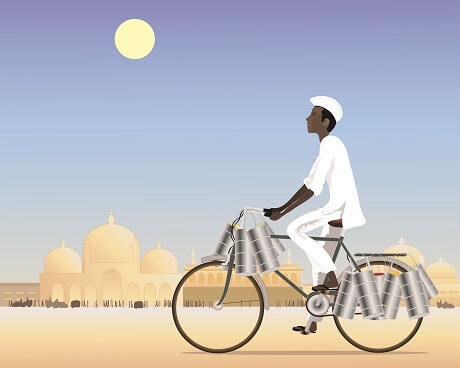- The first dabbawalla picks up the dabba from a home and takes it to the nearest metropolitan commuter railway station.
- The second dabbawalla sorts out the dabbas at the railway station according to destination and puts them in the luggage carriage.
- The third one travels with the dabbas to the railway stations nearest to the destinations.
- The fourth one picks up dabbas from the railway station and delivers them to each individual’s office.
- The process is reversed in the evenings with each dabba completing a distance of 60-70 kilometers and changing hands eight times.
- Customers pay $5 to $9 a month for this service, which also explains why Western cities hardly know these kinds of services . . . it would be too expensive.
- The system is a cooperative, which means that all the workers collectively own the business, are paid equally and share equally in the profit.
Every work day the dabbawallas pick up and deliver 200,000 lunch boxes within only a couple of hours, in a traffic-congested city whose population is more than 20 million.
It has been estimated that the dabbawalla’s on-time service delivery standard was 99.99998% . . . which exceeds Six Sigma standards! That is one late/missed delivery for every 6 million deliveries!
It has been said the Dabbawallas are the envy of Fedex.
The dabbawallas have started using internet technology to build their customer base. They are now carrying mobile phones. Their monthly delivery fees have increased and business is growing.
They have a long tradition in India, but how long will the dabbawallas last as an occupation?
There is a trend to eat out more often and use take-away food vendors at lunch time. And, women in younger generations are more likely to be working themselves so they are not at home to make mid-day meals for their husbands.
But, the strict dietary requirements of the various different religious groups in India make home made meals a necessity for many workers.
As in all countries, dining out is expensive, and the trains will continue to be overcrowded making it difficult for workers to carry their lunch dabbas in the passenger cabin.
I think it will be some time before the dabbawalla disappears.
Your thoughts?
Photo Courtesy of Wikipedia Creative Commons
Relevant links.
http://popupcity.net/dabbawalla-hot-lunch-delivery-by-mumbais-fastest/
https://hbr.org/2012/11/mumbais-models-of-service-excellence
https://www.youtube.com/watch?v=fTkGDXRnR9I
https://www.pri.org/stories/2014-07-15/indian-meal-service-so-efficient-it-s-envy-fedex
https://www.ft.com/content/f3b3cbca-362c-11e5-b05b-b01debd57852
https://phys.org/news/2006-06-bombay-dabbawalas-high-tech.html
In the research The Dunvegan Group conducts to support our CCR™ (Customer Care & Retention™) Programs, we discover articles, blog posts and videos which, although not directly related to our work, are thought-provoking or concern matters you may want to think about.
These posts are selected by The Dunvegan Group’s Vice President of Research, Olev Wain, Ph.D.
Dr. Wain is an expert in the measurement of customer perceptions that lead to specific behaviors; much of his career has been invested in identifying proprietary metrics in the Business-to-Business (B2B) world where there are multiple points of contact and complex processes for decision making.
The Business Retention Index™ and the Business Essentials Index™ are two powerful indicators of the strength of the bond between a B2B company and its customers created by Dr. Wain and utilized in The Dunvegan Group’s Customer Care & Retention™ Programs.

